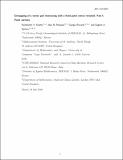Files in this item
Entrapping of a vortex pair interacting with a fixed point vortex revisited. I. Point vortices
Item metadata
| dc.contributor.author | Koshel, Konstantin V. | |
| dc.contributor.author | Reinaud, Jean N. | |
| dc.contributor.author | Riccardi, Giogio | |
| dc.contributor.author | Ryzhov, Eugene A. | |
| dc.date.accessioned | 2018-10-04T09:30:09Z | |
| dc.date.available | 2018-10-04T09:30:09Z | |
| dc.date.issued | 2018-09-28 | |
| dc.identifier | 255021667 | |
| dc.identifier | d772148b-1c12-4cef-85af-4fea3af8e017 | |
| dc.identifier | 85054300266 | |
| dc.identifier | 000446155900034 | |
| dc.identifier.citation | Koshel , K V , Reinaud , J N , Riccardi , G & Ryzhov , E A 2018 , ' Entrapping of a vortex pair interacting with a fixed point vortex revisited. I. Point vortices ' , Physics of Fluids , vol. 30 , no. 9 , 096603 . https://doi.org/10.1063/1.5040884 | en |
| dc.identifier.issn | 1070-6631 | |
| dc.identifier.other | ORCID: /0000-0001-5449-6628/work/48774869 | |
| dc.identifier.uri | https://hdl.handle.net/10023/16142 | |
| dc.description | The reported study was partially supported by the POI FEB RAS Program “Mathematical simulation and analysis of dynamical processes in the ocean” (No. 117030110034-7) and by the Russian Foundation for Basic Research, Project No. 17-05-00035. E.A.R. was partially supported by the NERC Grant No. NE/R011567/1. Thework of K.V.K. in obtaining the analytical estimates was supported by the Russian Scientific Foundation, Project No. 16-17-10025. | en |
| dc.description.abstract | The problem of a pair of point vortices impinging on a fixed point vortex of arbitrary strengths [E. Ryzhov and K. Koshel, “Dynamics of a vortex pair interacting with a fixed point vortex,” Europhys. Lett. 102, 44004 (2013)] is revisited and investigated comprehensively. Although the motion of a pair of point vortices is established to be regular, the model presents a plethora of possible bounded and unbounded solutions with complicated vortex trajectories. The initial classification [E. Ryzhov and K. Koshel, “Dynamics of a vortex pair interacting with a fixed point vortex,” Europhys. Lett. 102, 44004 (2013)] revealed that a pair could be compelled to perform bounded or unbounded motion without giving a full classification of either of those dynamical regimes. The present work capitalizes upon the previous results and introduces a finer classification with a multitude of possible regimes of motion. The regimes of bounded motion for the vortex pair entrapped near the fixed vortex or of unbounded motion, when the vortex pair moves away from the fixed vortex, can be categorized by varying the two governing parameters: (i) the ratio of the distances between the pair’s vortices and the fixed vortex and (ii) the ratio of the strengths of the vortices of the pair and the strength of the fixed vortex. In particular, a bounded motion regime where one of the pair’s vortices does not rotate about the fixed vortex is revealed. In this case, only one of the pair’s vortices rotates about the fixed vortex, while the other oscillates at a certain distance. Extending the results obtained with the point-vortex model to an equivalent model of finite size vortices is the focus of Paper II [J. N. Reinaud et al., “Entrapping of a vortex pair interacting with a fixed point vortex revisited. II. Finite size vortices and the effect of deformation,” Phys. Fluids 30, 096604 (2018)]. | |
| dc.format.extent | 4957615 | |
| dc.language.iso | eng | |
| dc.relation.ispartof | Physics of Fluids | en |
| dc.subject | Point vortex | en |
| dc.subject | Vortex topography | en |
| dc.subject | Interaction | en |
| dc.subject | Vortex interaction | en |
| dc.subject | QB Astronomy | en |
| dc.subject | QC Physics | en |
| dc.subject | NDAS | en |
| dc.subject.lcc | QB | en |
| dc.subject.lcc | QC | en |
| dc.title | Entrapping of a vortex pair interacting with a fixed point vortex revisited. I. Point vortices | en |
| dc.type | Journal article | en |
| dc.contributor.institution | University of St Andrews. Scottish Oceans Institute | en |
| dc.contributor.institution | University of St Andrews. Applied Mathematics | en |
| dc.identifier.doi | 10.1063/1.5040884 | |
| dc.description.status | Peer reviewed | en |
This item appears in the following Collection(s)
Items in the St Andrews Research Repository are protected by copyright, with all rights reserved, unless otherwise indicated.

